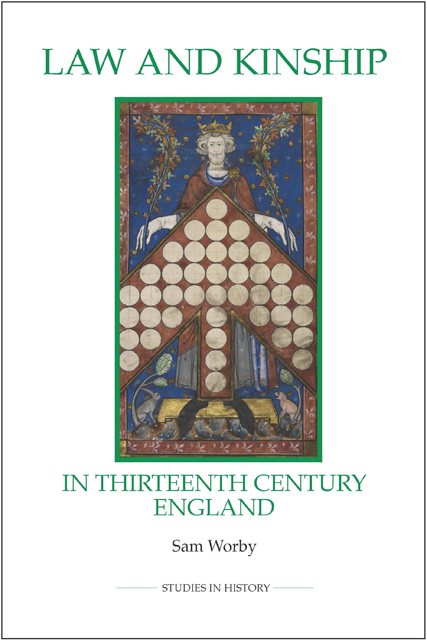Book contents
- Frontmatter
- Contents
- List of illustrations
- List of tables
- Acknowledgements
- Abbreviations
- Introduction
- 1 Canon law kinship structures
- 2 Common law kinship structures
- 3 The dominance of canon law kinship ideas
- 4 Kinship laws in practice
- 5 Trends underlying legal kinship structures
- Conclusion
- Appendices
- Bibliography
- Index
- Frontmatter
- Contents
- List of illustrations
- List of tables
- Acknowledgements
- Abbreviations
- Introduction
- 1 Canon law kinship structures
- 2 Common law kinship structures
- 3 The dominance of canon law kinship ideas
- 4 Kinship laws in practice
- 5 Trends underlying legal kinship structures
- Conclusion
- Appendices
- Bibliography
- Index
Summary
In late medieval England, in order to marry, or inherit, people had to fit their own experiences of family through formal legal frameworks, which thus had a social force beyond the purely taxonomic and intellectual. In thirteenthand fourteenth-century England the canon law was the foremost kinship system as a general framework for classifying the family. Even the common law, which had its own kinship system centred on inheritance, was touched by canon law ideas.
Charles Donahue Jr's magisterial comparative study of marriage in England, France and Belgium has confirmed a remarkable pattern of family interaction for England. His thorough and statistical analysis of the surviving records of cases before the archbishop of York's consistory court in the fourteenth and fifteenth centuries, and Ely consistory court between 1374 and 1381, incidentally seems to confirm that there was no clan or corporate kinship system operating in the areas covered, and, by inference, in England more widely (given the consistency of results between the two evidence sets). There were, he shows, even relatively low levels of parental involvement in marriage choice. Given the importance of marriage as a social institution and the potential consequences flowing from choice of partner – in property, alliance and social standing for example – it seems remarkable that an average of only 37 per cent of York cases showed evidence of parental involvement. While there was evidence for arranged marriages in the records of both courts, many couples appear to have acted independently. Whether this is qualified as ‘astonishingly’ or ‘unusually’ individualistic, the fact remains that many couples operated with relative freedom within the scope of the canon law marriage rules.
This individualistic pattern confirms a picture of family interaction for England found elsewhere, through evidence of marriage patterns, but also more broadly. From the Anglo-Norman nobility to later medieval peasants, the picture is of a limited family (although this book will not in fact focus on peasant kinship, but rather on kinship insofar as it was a general structure, transcending class and status). The extended kindred did not live together; the typical co-resident family appears to have been nuclear. There is evidence of kin interaction, particularly suggestive of closeness between siblings.
- Type
- Chapter
- Information
- Law and Kinship in Thirteenth-Century England , pp. 1 - 8Publisher: Boydell & BrewerPrint publication year: 2010

